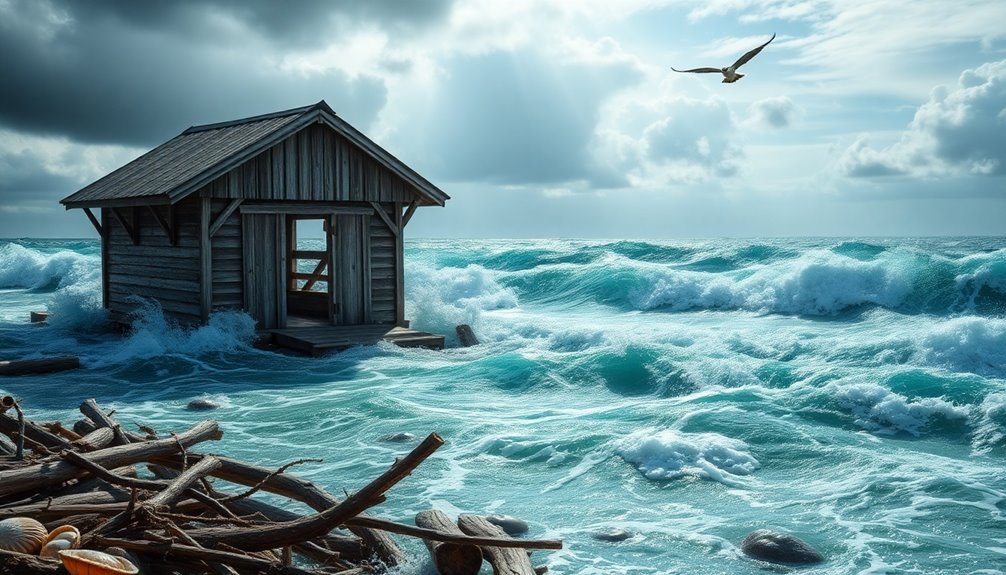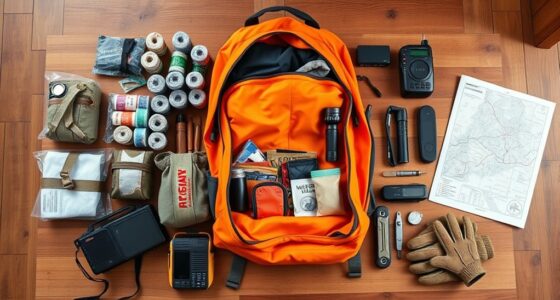Creating a safe haven at sea requires solid maritime safety protocols. You should ensure everyone on board knows their emergency roles and conduct regular drills to prepare for rough weather. It's vital to stock up on emergency gear like life jackets and flares, and familiarize your crew with communication procedures to eliminate confusion. Make sure to have advanced navigation tools to steer clear of hazards. Also, don't underestimate the importance of regular equipment checks and maintenance. By focusing on these aspects, you can enhance your safety at sea. Discover more strategies to fortify your floating sanctuary.
Key Takeaways
- Implement marine shelters, such as detached breakwaters, to provide safe refuge from harsh weather conditions and ocean swells.
- Regularly conduct safety drills to prepare crews for emergencies and enhance their problem-solving skills during rough seas.
- Equip vessels with reliable communication systems, like VHF radios, to ensure effective coordination during distress situations.
- Utilize advanced navigation technology to improve route planning and minimize the risk of accidents at sea.
- Collaborate with local organizations to support affected communities in recovering from ocean-related disasters and enhance overall maritime safety.
Introduction
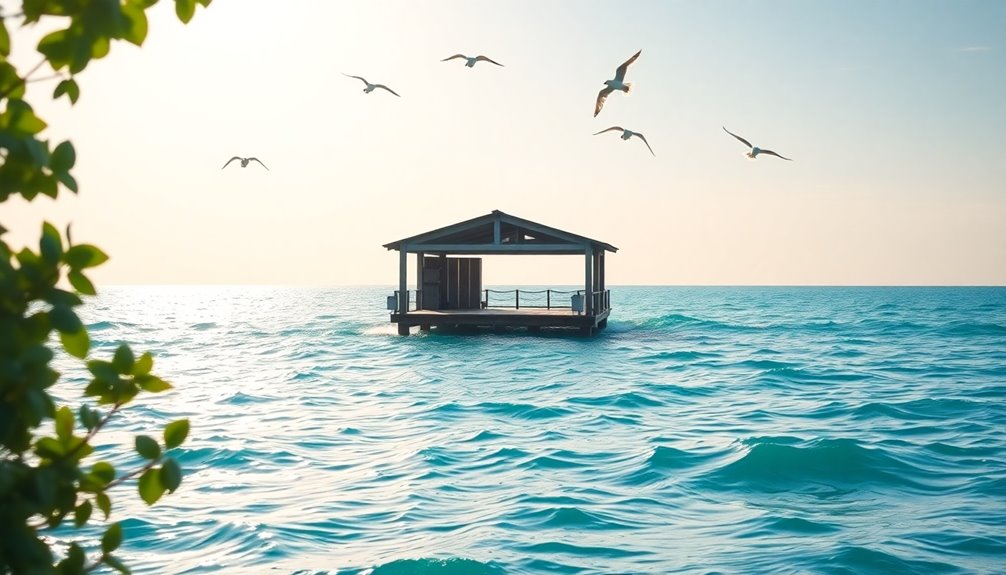
When you're out at sea, understanding maritime safety is crucial for your protection.
Establishing effective safety protocols can make all the difference in preventing disasters and ensuring a secure environment for everyone on board.
Overview of Maritime Safety
Maritime safety plays a crucial role in protecting vessels, crew, and passengers from the myriad hazards encountered at sea. It encompasses various practices designed to mitigate risks from adverse weather and navigational challenges.
The International Maritime Organization (IMO) sets global standards that member states must follow, ensuring a uniform approach to safety. With over 4,000 boating accidents annually in the U.S., the importance of safety measures like life jackets and operator education becomes clear.
Advanced technology, such as Automatic Identification Systems (AIS) and Global Positioning Systems (GPS), enhances navigation and collision avoidance, improving overall safety.
Additionally, comprehensive safety training, including emergency response drills, equips maritime personnel to handle emergencies effectively and protect lives at sea.
Establishing Maritime Safety Protocols
Establishing effective maritime safety protocols is vital for ensuring the well-being of everyone on board. You need clear guidelines that govern navigation, communication, and emergency response.
Regular safety drills for crew members are essential; they should be prepared for situations like man overboard incidents or equipment failures.
Maintain effective communication systems, such as VHF radios and AIS, to ensure immediate reporting of hazards or distress.
Regularly inspect and maintain safety equipment, including life jackets, flares, and fire extinguishers, to comply with maritime safety standards.
Collaborate with local port authorities and adhere to international regulations set by the International Maritime Organization (IMO) to foster a comprehensive safety culture at sea.
Your commitment to these protocols can make all the difference in critical moments.
Maritime Safety Protocols Defined
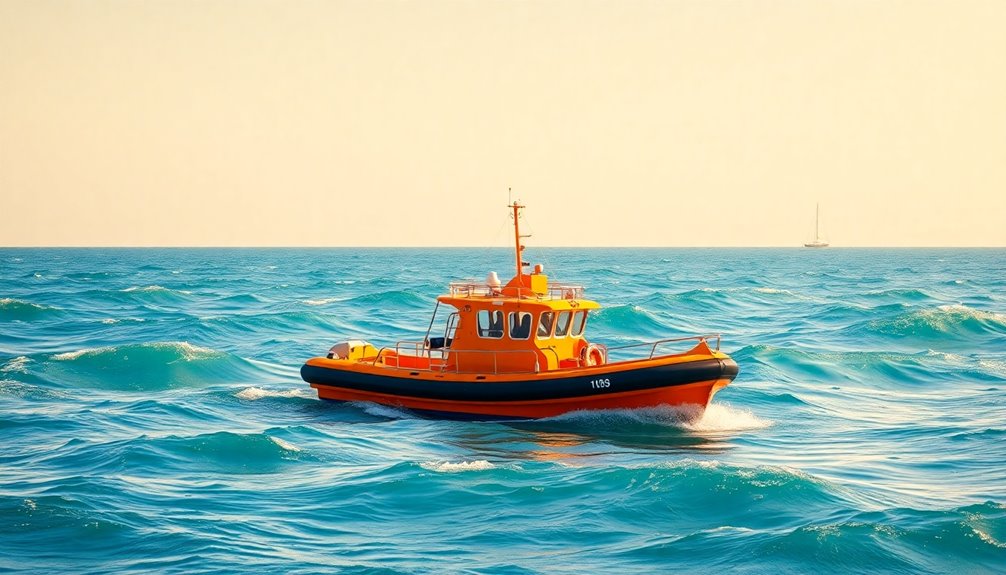
Ensuring safety at sea requires a comprehensive understanding of well-defined protocols that guide vessel operations and crew conduct.
Maritime safety protocols are essential for preventing accidents and ensuring the safety of both vessels and crew. These guidelines include crucial measures for emergency preparedness, such as regular safety drills like man-overboard and fire drills, which help your crew respond effectively in critical situations.
The use of personal flotation devices (PFDs) is also a fundamental aspect of these protocols, ensuring they're available and used properly, especially in high-risk areas or adverse weather.
Additionally, vessel safety inspections and maintenance schedules are vital to guarantee that all equipment, including life-saving appliances and navigational systems, functions correctly, minimizing risks while you navigate the open seas.
Essential for Emergency Preparedness
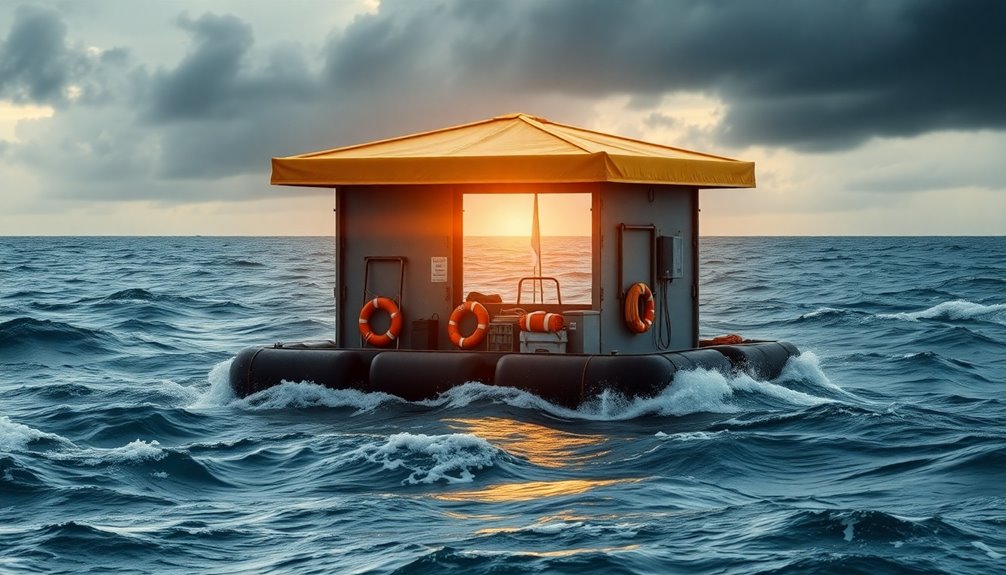
When you're out at sea, being prepared for emergencies is crucial to preventing accidents.
Always check weather conditions before you set sail, as changes can create dangerous situations that require quick action.
Preventing Maritime Accidents
Preventing maritime accidents is crucial for emergency preparedness, and it's a shared responsibility among all crew members.
Understanding weather-related factors is vital, as about 75% of maritime incidents stem from adverse conditions. You should implement regular safety drills and training to enhance your team's response times during emergencies.
Using advanced navigation technology like GPS and AIS can help avoid collisions, contributing to a 40% reduction in accidents.
Establishing clear communication protocols is essential; miscommunication causes nearly 70% of reported incidents.
Lastly, ensure regular maintenance and inspections of your vessel to prevent mechanical failures, which account for about 20% of accidents.
Adhering to safety regulations and guidelines will significantly enhance your preparedness and safety at sea.
Weather Conditions at Sea
Understanding weather conditions at sea is essential for your safety and emergency preparedness. Sudden storms can produce waves over 30 feet and winds exceeding 60 knots, creating significant risks.
You need to monitor weather forecasts closely, as meteorological phenomena like hurricanes can develop in just 24 hours. The National Oceanic and Atmospheric Administration (NOAA) provides crucial data on sea surface temperatures that influence storm development.
Familiarizing yourself with the Beaufort scale helps you assess wind speeds and potential dangers effectively. Utilize tools like satellite imagery and weather buoys to gain real-time updates on changing weather patterns.
Staying vigilant and informed can significantly enhance your ability to respond quickly and appropriately to any emerging maritime threats.
Emergency Signal Usage Guidelines
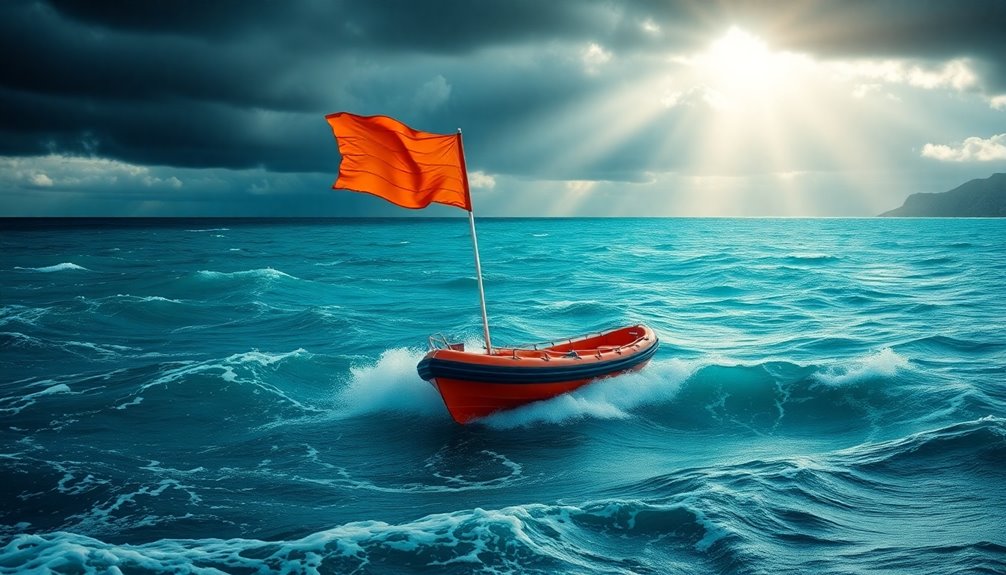
Effective emergency signal usage is crucial for ensuring your safety at sea. When you're in distress, using emergency signals like pyrotechnic flares can attract immediate attention, especially in low visibility conditions.
The International Maritime Organization recommends combining visual and audible signals, including distress flags and horn blasts, to effectively communicate your situation. Always carry at least three pyrotechnic flares on board; they're visible for miles and can significantly aid rescuers in locating you.
Make sure your emergency signaling devices are easily accessible and regularly checked for expiration dates. Additionally, familiarize yourself with the Global Maritime Distress and Safety System (GMDSS) to ensure you can use radio equipment for distress signaling, allowing for rapid communication in emergencies.
Safety Equipment and Gear
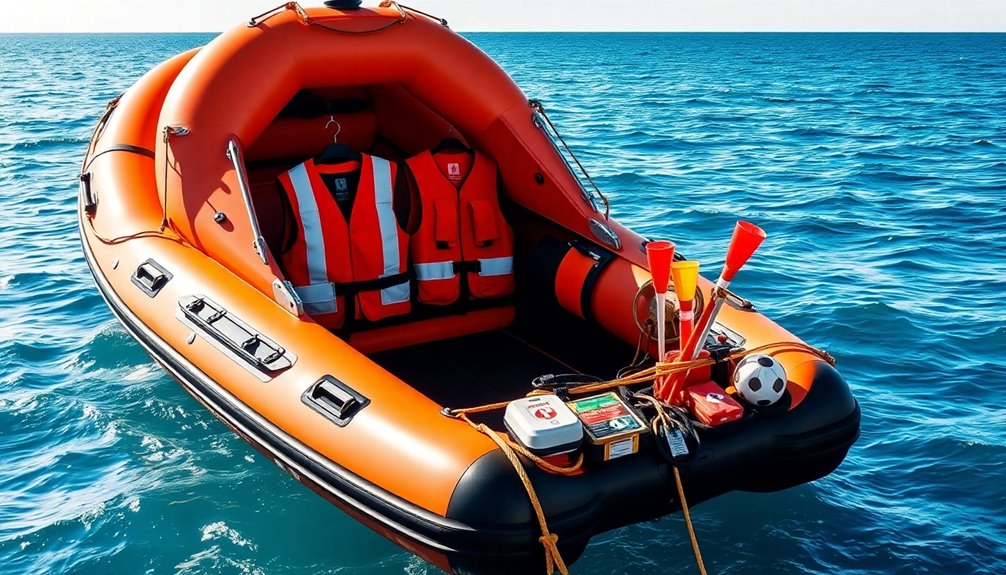
Safety equipment and gear can make all the difference when you're out on the water. Make sure you have U.S. Coast Guard-approved life jackets for every passenger, ensuring they fit properly for maximum buoyancy in emergencies.
Don't overlook the importance of a well-stocked first aid kit designed for marine use; it should include seasickness tablets, adhesive bandages, and waterproof dressings.
Also, carry at least three flares that are within their expiration dates to signal for help if needed. A marine VHF radio is essential for contacting the Coast Guard or other vessels in distress, significantly enhancing your safety.
Finally, keep a marine-rated fire extinguisher aboard, ensuring it's easily accessible and fully charged. Your safety depends on your preparedness.
Effective Communication Techniques
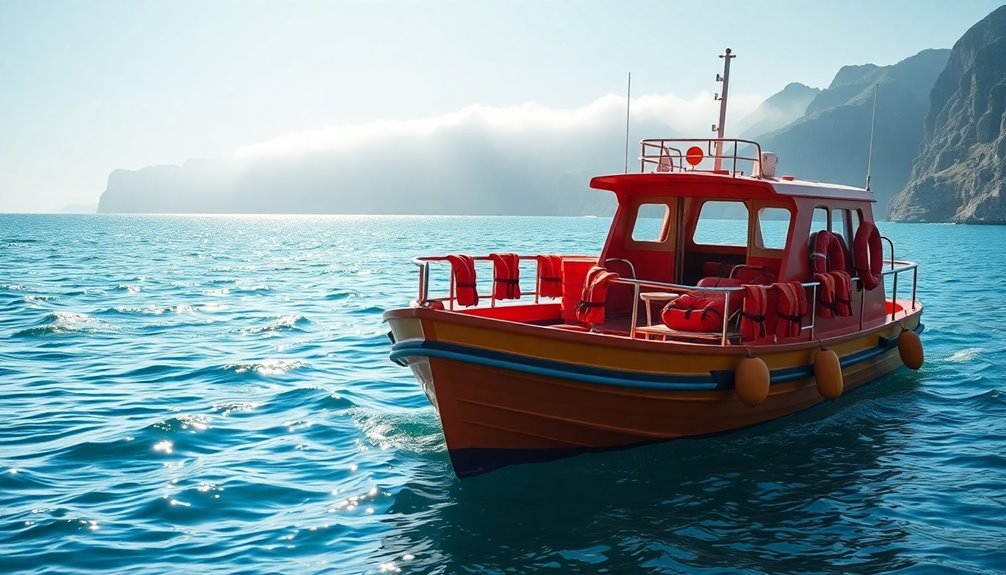
Good communication is key when you're out at sea, whether you're coordinating with your crew or signaling to other vessels.
Effective communication hinges on active listening; fully concentrate on the speaker, grasp their message, and respond thoughtfully. This fosters mutual understanding and keeps everyone on the same page.
Don't underestimate nonverbal cues—body language, facial expressions, and tone can shape how messages are interpreted. Use clear and concise language to minimize misunderstandings and convey your message accurately.
It's also crucial to adapt your communication style based on your audience's background and familiarity with the subject.
Lastly, feedback is vital; it clarifies points, reinforces understanding, and highlights areas for improvement, ensuring that conversations remain productive and effective.
Navigating Rough Weather Conditions
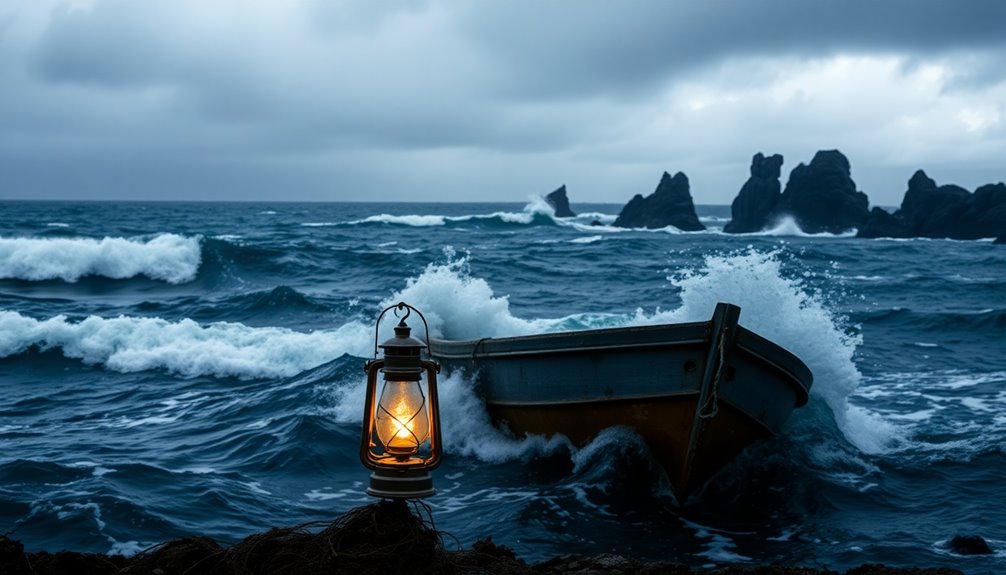
When you're out at sea, it's vital to conduct emergency drills with your crew to ensure everyone knows their roles during rough weather.
Regular safety training prepares you for unexpected situations and helps maintain calm under pressure.
Emergency Drills for Crew
Navigating rough weather conditions can be daunting, but regular emergency drills are essential for preparing your crew to handle any challenges that arise. Conduct these drills every six months to ensure everyone's familiar with safety protocols and procedures.
Simulating various scenarios, like sudden squalls or high seas, sharpens the crew's problem-solving skills and boosts confidence in real-life situations.
Implement a clear communication system onboard, so all crew members understand their roles during emergencies.
Don't forget to practice man-overboard recovery drills to enhance response time and coordination in adverse weather.
Finally, review and familiarize the crew with the vessel's safety equipment, including life rafts, flares, and emergency beacons, ensuring everyone's ready when severe weather strikes.
Safety Drills and Training
To effectively prepare for the challenges posed by rough weather, safety drills and training are essential.
You'll want to practice using life-saving equipment like life jackets, flares, and emergency beacons so each crew member knows their role in critical situations.
Regular man-overboard drills are crucial since 70% of boating accidents happen due to crew overboard incidents in adverse weather.
Incorporate weather forecasting tools, including radar and GPS, during training to help you assess conditions accurately.
Also, focus on effective communication protocols during emergencies, as clear dialogue reduces confusion and improves response times.
Successful Rescue Operations
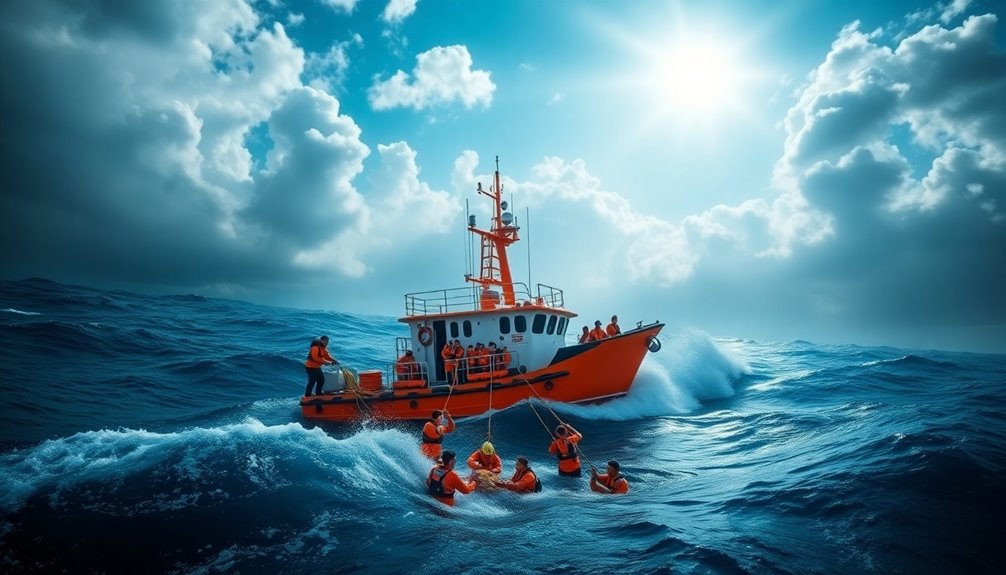
Successful rescue operations at sea hinge on the seamless coordination between various agencies, such as the Coast Guard, local maritime organizations, and dedicated volunteer groups.
These collaborations ensure rapid and effective responses to emergencies when time is of the essence. The "Mayday" distress signal plays a crucial role, allowing vessels in danger to communicate their precise location and needs to nearby ships and rescue authorities.
Advanced technology, like GPS and drone surveillance, enhances the accuracy of locating distressed vessels, improving rescue efficiency.
In 2022 alone, the U.S. Coast Guard reported over 23,000 search and rescue cases, saving more than 3,000 lives at sea.
Continuous training and simulations prepare teams for diverse maritime emergencies, ensuring they remain ready for action.
Conclusion
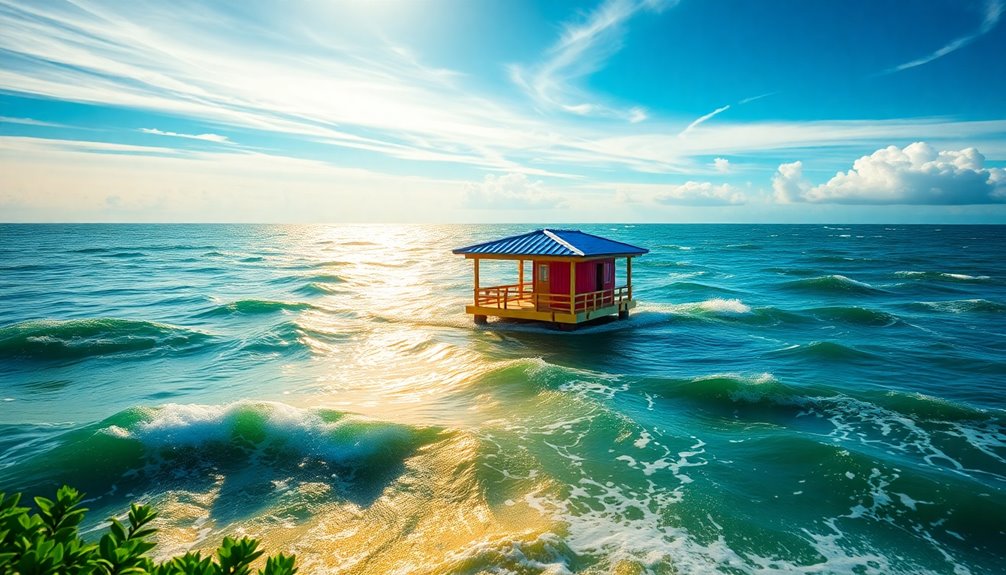
In light of the critical insights gained from successful rescue operations and the importance of innovative marine infrastructure, it's clear that protecting lives at sea requires a multifaceted approach.
Implementing well-designed marine shelters, including detached breakwaters, is vital for coastal protection and safe anchorage. You should consider environmental impact assessments to ensure that these structures don't harm local ecosystems.
Moreover, community-led initiatives play a crucial role in enhancing resilience, providing support to those affected by ocean swells and damages.
Additional Resources
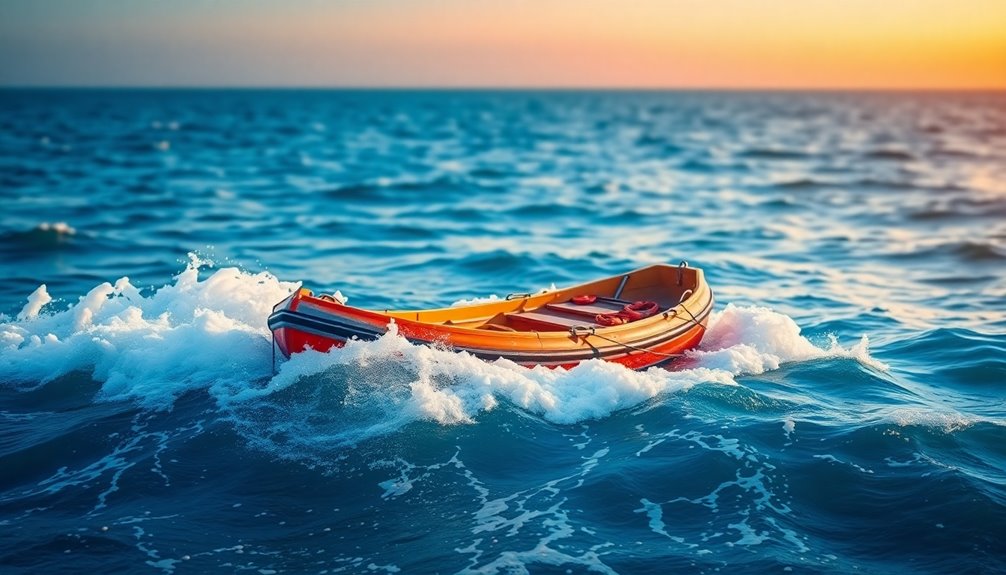
Access to reliable resources is essential for communities affected by ocean swells and related disasters.
In Santa Cruz, the Community Foundation is providing financial assistance to those who've lost homes or boats due to recent storms. Nonprofit organizations, like Community Bridges, are distributing $500 Visa gift cards to help displaced residents cover urgent expenses for shelter and basic needs.
With around 50 individuals living in the Santa Cruz Harbor facing significant losses, it's crucial to support this vulnerable liveaboard community. Local organizations are actively collaborating on community efforts to restore harbor access and infrastructure, ensuring that those impacted can find their footing again.
Additionally, exploring assistance programs can provide further financial support for those in need during this recovery period.
Stay connected to these resources to navigate through challenging times effectively.
Frequently Asked Questions
What Types of Boats Are Best for Shelter at Sea?
When considering the best types of boats for shelter at sea, you should prioritize stability and durability.
Catamarans offer excellent stability and space, making them great for long trips. Trawlers are also a solid choice, providing comfort and safety in rough waters.
If you're looking for something smaller, a well-equipped sailboat can work too, as long as it's designed for offshore conditions.
Always ensure your boat's properly equipped for emergencies and rough weather.
How Can I Ensure My Boat Is Seaworthy for Emergencies?
To ensure your boat's seaworthy for emergencies, start by checking the hull for cracks or damage.
Inspect the engine and fuel system, ensuring everything's in working order.
Test your safety equipment, like life jackets and flares, and make sure you've got enough supplies on board.
Regularly review your maintenance routine and keep a log of repairs.
Lastly, familiarize yourself with emergency procedures so you're prepared when it counts.
What Are Common Mistakes During Emergency Evacuations at Sea?
During emergency evacuations at sea, you might overlook vital preparations.
Common mistakes include failing to conduct regular drills, which can leave you unprepared when panic strikes. Not knowing your evacuation routes or the location of life jackets can also be detrimental.
You might underestimate the importance of communication, making it harder to coordinate with your crew.
Lastly, neglecting to account for weather conditions can lead to dangerous situations.
Stay vigilant and always plan ahead.
Can I Use My Smartphone as a Communication Device in Emergencies?
Yes, you can definitely use your smartphone as a communication device during emergencies.
It's equipped with various apps for messaging and calling, even in poor signal areas if you have Wi-Fi.
Don't forget to keep it charged and download emergency contacts ahead of time.
However, keep in mind that in some situations, satellite phones or specific marine radios might be more reliable.
Always have a backup plan in case your smartphone fails.
How Do I Maintain Morale Among Passengers During a Crisis at Sea?
To maintain morale among passengers during a crisis at sea, you need to stay calm and communicate clearly.
Keep everyone informed about the situation and the steps you're taking. Encourage teamwork by assigning roles, so everyone feels involved.
Share uplifting stories or music to lighten the mood. Regularly check in with passengers, offering support and reassurance.
Remind them of the importance of staying positive and working together to overcome the challenges ahead.

